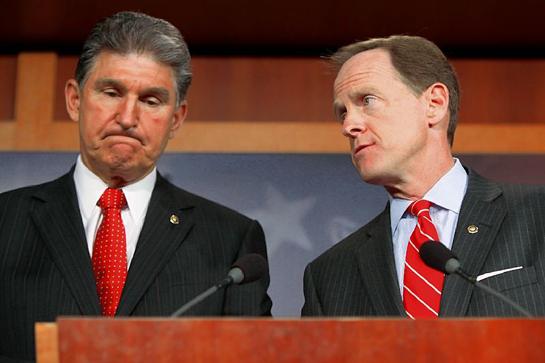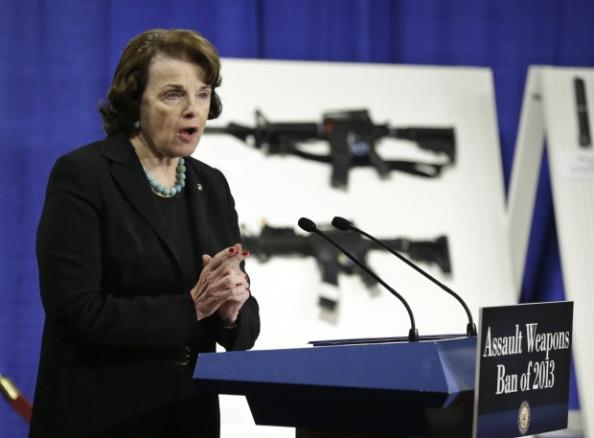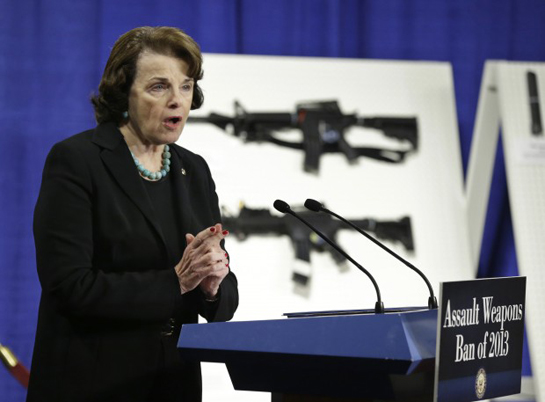We may earn revenue from the products available on this page and participate in affiliate programs. Learn More ›
The year of 2013 saw more political battles over gun control than any time since the Clinton era. Some good bills were passed, some detrimental bills were passed, but most of the legislation never survived Congress. To help put the year in perspective, we’ve summarized the 9 biggest 2nd Amendment stories of 2013.
1) Historic Senate vote slows anti-gun rhetoric

In a dramatic victory of logic over knee-jerk emotion, the U.S. Senate on April 17 derailed the gun control lobby’s campaign to capitalize on the Newtown shootings when it rejected all seven proposed amendments to the first gun control bill debated on its floor since 1994.
Gun control advocates vowed to rally the American people to force the Senate to reconsider the vote, only to learn that in espousing a cause that only dilutes the Constitution without addressing the problem, their initiatives made no sense to the people they claimed to represent.
The vote ended momentum for new federal guns laws in 2013 and, many pundits predict, until after the 2014 mid-term elections. While the amendments included a proposed universal background check requirement (see story #2), Sen. Dianne Feinstein’s draconian semi-automatic firearms ban (see story #3), and a 10-bullet magazine capacity limit, others included proposals for national concealed carry, strengthening veterans’ gun-owning rights, and making gun trafficking a federal crime.
“A series of Senate votes (on April 17) marked the biggest moment in nearly two decades for those who want to limit guns in America, and for those who don’t,” wrote Connie Cass of the Associated Press on April 18. “Gun control failed.”
The seven amendments needed 60 votes to pass the Democrat-controlled Senate. Even if approved, they would not have passed the Republican-dominated House.
The seven amendments:
* The proposed Public Safety and Second Amendment Rights Protection Act failed in a 54-46 vote. Sens. Joe Manchin’s (D-W.V.) and Pat Toomey’s (R-Pa.) compromise bill would have required buyers to undergo background checks at gun shows and for online sales without imposing federal record-keeping regulations on private transactions.
* The Protecting Communities and Preserving the Second Amendment Act of 2013 failed in a 52-48 vote. The bill, co-sponsored by Sens. Charles Grassley (R-Iowa) and Ted Cruz (R-Texas), would have increased funding for criminal prosecution, school safety, mental health resources and create a task force to go after felons who fail background checks. Nine Democrats supported it: Baucus, Begich, Joe Donnelly (Ind.), Kay Hagan (D-N.C.), Heitkamp, Mary Landrieu (La.), Claire McCaskill (Mo.), Pryor and Jon Tester (Mont.). Two Republicans, Mark Kirk (Ill.) and Mike Lee (Utah), opposed.
* Gun trafficking amendment failed in a 58-42 vote. It would have made gun trafficking a federal crime and strengthened the penalties against “straw purchasers.” This amendment was supported by the NRA.
* Constitutional Concealed Carry Act failed in a 57-43 vote. Sen. John Cornyn’s (R-Texas) bill would have given gun owners the right to carry concealed weapons across state lines and into other states that also have concealed-carry laws without obtaining a new license.
Dianne Feinstein’s semi-automatics weapons ban — sham title: “assault weapons” ban — failed in a 40-60 vote. Sen. Kirk of Illinois, where a Republican can apparently vote against the Constitution with impunity, was the only member of the GOP to vote for it.
* Expanding veterans’ gun rights amendment failed in a 56-44 vote. Sponsored by Sen. Richard Burr (R-N.C.), under the bill, a court would have to determine that a beneficiary is a danger to him/herself or others before gun rights can be revoked. No Republican voted against it.
* High-cap magazine ban amendment failed in a 46-54 vote. Introduced by Sens. Frank Lautenberg (D-N.J.) and Richard Blumenthal (D-Conn.), if passed the bill would have limited the capacities of magazines to 10 rounds. Again, Illinois’ Kirk was the only Republican to vote for it.
2) Background checks proposal gone for 2013 … but not forgotten

Senators Joe Manchin (D-W.V.) and Pat Toomey (R-Pa.) explaining their compromise background check bill.
The day after the U.S. Senate rejected all seven proposed amendments to the first gun control bill debated on its floor since 1994, there was speculation that the hotly debated universal background checks bill would be reintroduced and passed before the end of 2013.
On April 18, Senate Majority Leader Harry Reid (D-Nev.) announced that was unlikely, conceding there was no way the proposal would garner the 60 votes necessary to pass – at least until 2014.
The Public Safety and Second Amendment Rights Protection Act, a compromise bill sponsored by Sens. Joe Manchin’s (D-W.V.) and Pat Toomey’s (R-Pa.), would have required buyers undergo background checks at gun shows and for online sales without imposing federal record-keeping regulations on private transactions.
The Manchin/Toomey compromise Public Safety and Second Amendment Rights Protection Act failed in a 54-46 vote on April 17. Four Democrats opposed the amendment: Max Baucus (Mont.), Mark Begich (Alaska), Heidi Heitkamp (N.D.), and Mark Pryor (Ark.). Four Republicans supported it: Susan Collins (Maine), Mark Kirk (Ill.), John McCain (Ariz.), and Toomey.
The Senate rejected the bill despite overwhelming public support — up to 90 percent, according to some surveys — for tightening gun purchase requirements and disclosure. In a December analysis by Nate Silver of the New York Times, senators up for re-election in 2014 from states with low gun ownership rates voted for the amendment while those from states with high gun ownership rates voted against the amendment. Another contributing factor, according to Silver, is much of the public may favor expanded background checks, but don’t, necessarily, support the Manchin/Toomey bill.
The irony is the Public Safety and Second Amendment Rights Protection Act was viewed as a more tolerable alternative to the proposed Fix Gun Checks Act of 2013 sponsored by Sen. Chuck Schumer (D-NY). Schumer introduced versions of the same bill in 2011 and 2012. Among its most distinctive features was it required uniform background checks for all firearm sales other than “gifts” among families, amended the NICS Improvement Amendments Act of 2007 to impose penalties on states for failing to meet federal data reporting standards, and broadened the definition of those with mental and emotional illnesses prohibited from possessing firearms.
In early April, with Schumer’s proposed Fix Gun Checks Act of 2013 facing certain stalemate and a GOP filibuster that could bury it before reaching the Senate floor, Manchin and Toomey tried to salvage efforts to tighten background check regulations with their bipartisan compromise bill.
Less than two weeks after the Public Safety and Second Amendment Rights Protection Act was rejected, Manchin told Fox News Sunday that her planned to eventually re-introduce the bill. “I’m willing to go anywhere in this country, I’m going to debate anybody on this issue, read the bill and you tell me what you don’t like,” Manchin said.
On Sept. 23, however, after gun control proponents attempted to capitalize on the Navy Yard City shooting to lobby for reviving the compromise background bill, Manchin said he had no plans to push for the measure because there was little support for it in the Senate and, according to two polls, among the American people.
In an Aug. 1 meeting in Washington, D.C., with Moms Demand Action for Gun Sense in America, Reid said that Congress has so many pressing, complex issues on its agenda, another vote on background checks won’t happen any “sooner than 2014,” but would occur before midterm elections.
“I think sometime next year we’ll revisit that issue,” Reid said. “I’m almost certain of it.”
3) ‘Assault weapons’ ban scam exposed as a Feinstein fraud

Senator Dianne Feinstein promoting gun control legislation.
Constitution-hating huckster Sen. Dianne Feinstein’s (D-Calif.) proposed semi-automatic weapons ban was overwhelmingly rejected by the Senate on April 17, ending any realistic chance among the sober and sane that the Clinton Era semi-automatic ban would be disinterred but not, sadly, ending Feinstein’s mind-sapping influence on national affairs.
Had that happened, this would not be top story #3 of 2013, but a contender for top story of the decade.
Feinstein, eagerly seeking to capitalize on the Newtown shootings, formally introduced her revived automatic weapons ban “on steroids” on Jan. 24. Her bill, fraudulently called the “Assault Weapons Ban of 2013,” proposed to ban the “sale, transfer, importation, or manufacturing” of more than 100 specifically named firearms, including semi-auto rifles, handguns and shotguns that accept detachable and fixed magazines of more than 10 rounds and have one or more “military characteristics.”
Gun owners knew that the nebulous and scary-sounding “assault weapon” in Feinstein’s 122-page bill was nothing more than a political designation that magically made a semi-automatic firearm an “assault weapon” by adding a detachable magazine and one cosmetic feature, such as a pistol grip or folding stock.
Therefore, most gun owners knew that “assault weapons” aren’t made, they’re contrived by political whim. Shooters knew this, but most non-shooters — including many in the mainstream media — did not.
These are the people Feinstein shamelessly tried to manipulate.
Unfortunately for Feinstein, the facts caught up with her bill before it could advance. In February, the NRA obtained and published a Department of Justice report that concluded any proposed semi-automatic weapons ban is “unlikely to have an effect on gun violence.”
“Since (semi-autos) are not a major contributor to U.S. gun homicide and the existing stock of guns is large, an ‘assault weapon’ ban is unlikely to have an impact on gun violence,” the DOJ report stated.
In mid-March, Feinstein’s proposed semi-auto ban squeaked out of the Democratic-led Senate Judiciary Committee in a 10-8 partisan vote that cast doubt on its ability to muster the 60-vote threshold necessary to foil a filibuster in the 100-seat Senate.
All 45 GOP senators denounced it and at least 20 Democratic senators from rural states, including Majority Leader Harry Reid of Nevada, expressed reservations about it. Several Democrats, such as Sen. Joe Manchin of West Virginia — co-author of the compromise universal background bill — and Sen. Max Baucus of Montana vowed to vote against it.
Feinstein’s fraud garnered only 40 votes when presented to the Senate on April 17, falling 20 votes short of the needed 60.
Unlike the failed universal background checks bill, which is likely to resurface after the 2014 mid-term elections, if not sooner, it is very unlikely that Feinstein’s proposed semi-auto ban in anything resembling its 2013 iteration will see the light of day anytime in the near future.
4) Political fallout from Obama’s gun control campaign spurs backlash in the Heartland

President Barack Obama and Vice President Joe Biden at a press conference announcing presidential orders.
On Jan. 16, President Barack Obama delivered 23 presidential orders that included support for an semi-automatic weapons ban, outlawing ammunition clips that hold more than 10 bullets and requiring background checks for every gun buyer in America.
Those initiatives would materialize in proposed legislation defeated in the Senate on April 17. (See story #1)
While Obama’s avowed support for these gun control measures was significant in itself, the resistance it fostered among law enforcement and elected officials nationwide not only underscored the vagaries and varieties of state gun laws nationwide, but served as a stage-setter to understanding the next battle over the Second Amendment — the 10th and 14th amendments.
Within a day of Obama issuing his 23 executive orders, at least four sheriffs announced that they would not enforce any federal regulation resulting from his gun control proposals, and legislators in Wyoming, Texas and Tennessee, as well as Mississippi Gov. Phil Bryant, vowed to introduce legislation that would make it illegal to enforce a federal gun ban in their states.
By Feb. 1, according to the Constitutional Sheriffs and Peace Officers Association, at least 226 sheriffs across the U.S. had vowed not to enforce any federal law they maintain violated the Second Amendment.
By Feb. 4, according to the Tenth Amendment Center, legislators in 16 states had introduced proposals to prohibit the federal government from imposing taxes on firearms, banning firearms and tracking firearms in their state.
Among them:
* Twenty-eight of 29 Utah county sheriffs sent Obama letters saying they would not enforce gun laws they believe would violate the Second Amendment.
* Two Oregon sheriffs, Linn County Sheriff Tim Mueller and Crook County Sheriff Jim Hensley, sent a letter to Vice President Joe Biden saying they would not enforce any federal regulation “offending the constitutional rights of my citizens.” Both sheriffs said they would not permit federal officers to come to their counties to enforce any new federal gun laws that ban now-legal weapons.
* Pine County (Minnesota) Sheriff Robin K. Cole issued a statement saying his department and deputies would not enforce “any mandate, regulation or administrative rule that violates the United States Constitution or it various amendments. I would view any such mandate, regulation or administrative rule illegal and refuse to carry it out.”
* Wyoming State Rep. Kendell Kroeker (R-Evansville) introduced legislation to make enforcement of any ban on assault weapons and high-capacity magazines a felony in the state. Kroeker’s bill would imprison federal agents for up to five years in prison and fine them $50,000 for attempting to enforce such bans in Wyoming.
* Texas State Rep. Steve Toth (R-The Woodlands) introduced legislation making it illegal for enforcement of a federal ban in Texas. “At some point there needs to be a showdown between the states and the federal government over the Supremacy Clause,” he said. “It is our responsibility to push back when those laws are infringed by King Obama.”
* Tennessee State Rep. Joe Carr (R-Murfreesboro) introduced a bill making it a misdemeanor for federal law enforcement agencies to enforce any new federal gun bans in Tennessee. Carr said the proposed legislation will allow residents to “defend themselves from tyranny.” Other lawmakers wanted to make it a Class B felony if any federal employee tries to confiscate guns in the state.
* Utah state Rep. Brian Greene (R-Pleasant Grove) introduced the State Supremacy Firearms Act, which restores state sovereignty protected by the 10th Amendment of the Bill of Rights, which gives states regulatory authority over anything not specifically delegated to the federal government — including firearms.
Legal analysts agree that, for the most part, sheriffs and state lawmakers were merely blowing off rhetorical, symbolic steam and had no real recourse in challenging any new federal gun control laws. But the mere fact that they made these statements and passed these resolutions underscores a division that is anything but rhetorical or symbolic.
5) Concealed carry: Good, bad, and ugly

It was a dynamic and eventful year for concealed carry advocates, highlighted by Illinois being forced to grudgingly acknowledge that the U.S. Constitution and Bill of Rights is, indeed, the law of the land and “allow” residents to carry concealed firearms — the last state in the nation to do so.
But there were setbacks as well, with the Senate again rejecting the proposed National Concealed Carry bill, court rulings in three states sustaining what many legal scholars maintain are unconstitutional restrictions on concealed carry and the Supreme Court refusing to hear a case advocates say merited review.
According to Adam Winkler, a UCLA professor of constitutional law and author of “Gunfight: The Battle Over the Right to Bear Arms in America,” concealed carry will continue to be a contentious issue in the coming years.
“The next great battle in the war over the Second Amendment is going to be who gets to argue concealed carry rights,” he writes.
A breakdown:
* On Feb. 22, the 7th Circuit Court ordered Illinois lawmakers to rewrite the nation’s toughest restrictions on carrying a concealed weapon in public by mid-June, upholding the court’s December 2012 decision that struck down as unconstitutional Illinois’ total ban on carrying firearms for self-defense outside one’s home or business.
On May 31, the Illinois State Legislature passed a new law that created a $150 concealed weapons permit valid for five years that would be issued by the Illinois State Police to applicants 21 and older. The law went into effect on July 9, making concealed carry legal in all 50 states.
* On Feb. 25, the 10th Circuit Court in Denver ruled in Peterson v. Martinez that concealed carry bans are constitutional, citing a Supreme Court ruling that “the right of the people to keep and bear arms is not infringed by laws prohibiting the carrying of concealed weapons.”
* On April 17, the Constitutional Concealed Carry Act failed in a 57-43 vote. Sen. John Cornyn’s (R-Texas) bill would have given gun owners the right to carry concealed weapons across state lines and into other states that also have concealed-carry laws without obtaining a new license.
* On July 31, the U.S. Third Circuit Court in a 2-1 vote upheld a New Jersey law that requires people to show a “justifiable need” to receive a concealed weapons permit.
The Second Amendment Foundation, the Association of New Jersey Rifle & Pistol Clubs and four residents denied permits because they could not show “justifiable need” for carrying a gun in public argued in their 2010 suit that a law that requires gun owners who want a concealed weapons permit to ask permission from a police official or a judge is an unconstitutional restraint on their Second Amendment right to own a firearm.
*On Oct. 15, the Supreme Court refused to hear the Second Amendment Foundation’s constitutional challenge of Maryland’s “good and substantial reason” handgun permit requirement.
Plaintiff Raymond Woollard and the Washington state-based SAF said Maryland’s “may issue” law violates the Second Amendment by restricting it beyond the doorstep.
Maryland is one of six “may issue” states where residents must demonstrate a reason to get a permit to carry a gun in public. Those states include California, New Jersey, New York, Massachusetts and Hawaii.
6) State governments: Colorado becomes 7th state to impose magazine capacity limits

Colorado Governor John Hickenlooper signed aggressive new gun-control legislation.
During the 2013 legislative session, Colorado became the seventh state to impose magazine capacity limits and the 14th to mandate universal background checks for all firearms sales, including private and online purchases. Meanwhile, with Illinois, Delaware, Maryland and Rhode Island prohibiting “assault weapons” in 2013, now 11 states ban many commonly used and widely owned semi-auto firearms.
According to John Mountjoy, Director of Policy and Research and Strategic Initiatives for the Council of State Governments, semi-automatic weapon bans were introduced in 18 states, magazine capacity caps in 20 legislatures and universal background checks in 21 states in 2013.
It wasn’t all one-sided: The Law Center to Prevent Gun Violence reports that while more than 600 gun control bills were introduced nationwide, about 540 bills seeking to expand gun rights were filed in 26 states.
Among bills expanding gun owners’ rights is Indiana’s new handgun law, which allows people to carry a handgun without a license inside their vehicles. In Mississippi, state residents now have the right to openly carry firearms without a gun permit. A new law in Tennessee allows handgun permit holders to store firearms and ammunition in their vehicles, no matter where they’re parked, goes into effect today.
The most notorious anti-Second Amendment new state law of 2013 was New York’s Secure Ammunition and Firearms Enforcement (SAFE) Act. It was also the first knee-jerk state legislation to surface in the wake of the Newtown shootings.
Effective April 15, among its many restrictions, New York’s 122-page SAFE Act imposed universal background checks for all gun sales, including all private, person-to-person sales, and limited magazine capacity to seven rounds — an impractical restriction that was amended in response to ridicule.
In traditionally gun-friendly Colorado, Democrats pushed a 15-round magazine capacity limit and universal background checks for all firearms sales through the legislature in bills signed into law by Gov. John Hickenlooper in March.
The law spurred an immediate legal and political fallouts. On May 17, 54 of Colorado’s 64 elected county sheriffs signed onto a lawsuit in U.S. District Court in Denver challenging the constitutionality and practicality of the new state law.
The lawsuit would prove unsuccessful but voters in Colorado Springs and Pueblo wouldn’t on Sept. 10 when they fired two Democratic lawmakers — Senate President John Morse and Sen. Angela Giron — for supporting the gun control laws in the first recall elections of any state officials in Colorado’s 137-year history.
The recall campaign against Giron in Pueblo was also significant because of the way grassroots activists used technology to galvanize support. According to the Washington Times, three Pueblo plumbers formed “one of the more unlikely insurgencies of the year in American politics … and stunned Colorado’s political establishment by doing what many campaign veterans insisted was impossible.”
The “plumbers” — Victor Head, Adam Head, and Ernest Mascarenas — forced Giron’s recall election “armed with little more than a petition, an army of volunteer signature-gatherers and their iPhones,” the Times reported.
In June, Nevada Gov. Brian Sandoval vetoed a bill requiring background checks for gun sales between private parties, telling the Las Vegas Sun that it “imposes unreasonable burdens and harsh penalties upon law-abiding Nevadans, while doing little to prevent criminals from unlawfully obtaining firearms.”
Between Oct. 11-13, California Gov. Jerry Brown signed 11 firearms-related laws, including one law that makes California the nation’s first state to prohibit the use of all lead ammunition for hunting. Another bans the sale of parts and repair kits that can create or convert a magazine to a capacity greater than 10 rounds.
Brown vetoed seven firearms-related bills. Among them was a measure that classified all semi-automatic rifles with a detachable magazine, or holding more than 10 rounds, as “assault weapons” that owners would need to register and pay a special tax to legally retain.
7) Gunmakers in Colorado and New England consider moving to pro-gun states

Firearms manufacturers in Connecticut, New York and Colorado announced in 2013 that they are moving or pondering a move in response to gun control measures adopted during the year.
In August, The Tennessean newspaper reported that Remington Arms, which has manufactured firearms in upstate New York for more than 150 years, is looking at sites around Nashville, Tenn., for a potential corporate relocation or expansion that would likely include hundreds of manufacturing jobs.
Remington’s 1,200-employee plant in Ilion, N.Y., makes rifles such as the Bushmaster, which are now banned under New York’s Secure Ammunition and Firearms Enforcement (SAFE) Act, which was adopted by state legislators in January.
In June, Kahr Arms of Rockland County, N.Y. announced it would be moving some of its operations to Pennsylvania. Kahr had been considering building a new plant, with 80-100 additional jobs, in Orange County, N.Y. When asked about the move by the Wall Street Journal, Kahr Vice President of Sales and Marketing Frank Harris said of New York, “We don’t feel welcome.”
New York is also being boycotted by several firearms manufacturers because of the SAFE Act. On Feb. 3, Washington-state-based Olympic Arms, a manufacturer of AR-15s and other semi-automatic rifles, announced it will no longer sell its products to New York state law enforcement agencies, three days after Templar Custom Arms made a similar pledge.
On April 4, Connecticut legislators passed Senate Bill 1160, Democratic Governor Dannel Malloy’s gun control package, imperiling the state’s firearms industry, which employs 3,000 state residents, creates 4,000 “indirect” jobs and generates $1.75 billion annual taxable revenues.
The first shoe to drop was Bristol-based PTR Industries, which on June 19 confirmed that is moving to Aynor, S.C., near Myrtle Beach. South Carolina Gov. Nikki Haley attended the June 24th ribbon-cutting ceremony. PTR will maintain an investment of $8 million and at least 145 employees at an average wage of $19.39.
Stag Arms, which employs more than 200 people in New Britain, assured it will not leave Connecticut — for now — but is looking to expand either in South Carolina or Texas. “We had planned on growing in Connecticut and creating jobs here but with the uncertainty of the government, it’s difficult to do that,” Stag Arms President Mark Malkowski told the New Britain Herald on July 1. “We’re going to see how we do in another area. Then I’ll make a decision on whether we’ll move from Connecticut at a later date.”
In July, Sturm, Ruger & Co. of Southport, which also employs more than 2,000 people in two plants in Newport, N.H., and Prescott, Ariz., announced that it would open a new plant to employ 470 workers in Rockingham County, N.C., rather than in Connecticut.
Magpul, of Boulder, Colo., which employs more than 200 people and generates about $85 million in annual taxable revenues, announced in February that it will leave Colorado after state legislators approved several gun control bills, including a magazine limit of 15 bullets.
In October, the company confirmed that it still planned to move out of state by had not stipulated where.
In June, HiViz Shooting Systems announced it will move from Fort Collins, Colo., to Laramie, Wyo., in 2014 in response to tightened gun regulations. HiViz sells 130 products in 30 countries. Within a decade of moving to Laramie in 2014, HiViz plans to create 56 direct and indirect jobs, $21.3 million in payroll from those direct and indirect jobs, provide $858,000 in local tax revenue, $303,000 in state tax revenue, and support 43 households in Laramie.
South Carolina, Pennsylvania, Mississippi, Missouri, Tennessee and Oklahoma are among the states courting gun-makers from anti-gun states, although Texas has been the most aggressive in selling itself to these lucrative companies and the craftsmen they employ.
In early February, Texas Governor Rick Perry sent letters to 26 gun and ammunition manufacturers inviting them to move their businesses to his state. Perry also made a 4-day trip to California last month and ran some ads on radio, hoping that a personal appeal might lure business away.
Earlier in the year, Texas Attorney General Greg Abbott reached out not just to the state’s gunmakers, but to disgruntled New York gun owners, inviting them to ditch the Empire State and come to Lone Star State in a series of ads published in the New York Times, Wall Street Journal and various news websites in Manhattan and Albany. “WANTED: Law-abiding New York gun owners seeking lower taxes and greater opportunities,” the ad reads. “Keep your guns, come to TX.”
8) Technology outpaces lawmakers’ ability to regulate 3D-printed firearms

Cody Wilson of Defense Distributed fires the first functional 3D-printed gun.
Technology is outpacing the capacity of legislators to regulate an ever-growing array of quickly evolving products, ranging from pharmaceuticals to synthetic fuels. Firearms, as 2013 made vividly clear, are no different as federal and state legislators were confronted with technological advances, such as 3D-printed guns and garage-modified “drones,” that tested their ability to adopt laws and regulations that safeguard public safety while preserving the integrity of the Constitution.
On Dec. 3, the U.S. House of Representatives voted to extend the Undetectable Firearms Act, a 1988 law banning any weapon that can evade metal detectors. Lawmakers pushed to extend the law, which was set to expire on Dec. 9, amid fears that 3D printing would give “evil-doers” a chance to smuggle a weapon into a secure building.
The bottom line is 3D printers and designs for 3D-printed guns, such as the Liberator, is rapidly increasing as the technology becomes mainstream.
The newly re-adopted Undetectable Firearms Act doesn’t make any direct reference to 3D printing, it still applies to 3D-printed guns because they are plastic and could potentially dodge security checks.
If February, Defense Distributed — a nonprofit dedicated to thwarting efforts by anti-gun lawmakers to ban 3D guns before they become widely available — announced the establishment of the “Wiki Weapon Project” — an attempt to design a firearm that may be downloaded from the internet and “printed” with a 3D printer.
Though printing guns is a craft still in its infancy, 3-D printers offer a potentially easy way around proposed gun control restrictions and registrations. Technology experts, gun rights proponents and gun safety advocates say printable firearms and ammunition magazines pose a challenge for President Obama and lawmakers as they ponder sweeping gun-control legislation.
“People all over the world are downloading this stuff all the time — way more people than actually have 3-D printers,” Cody Wilson, a University of Texas law student who co-founded Defense Distributed, told Michael S. Rosenwald of the Washington Post. “This is hot stuff on the Internet now.”
After Obama launched his gun-control campaign in early January, the group posted several videos to YouTube of AR-15s firing rounds with 3-D printed high-capacity magazines and lower receivers. The 3-D parts are made from high-grade polymer and retrofitted to the bodies of existing weapons.
Wilson said AR-15 blueprints have been “downloaded hundreds of thousands of times” from his group’s Web site.
“This is a symbolic challenge to a system that says we can see everything, regulate everything,” he told the Rosenwald. “I say, ‘Oh really?’ My challenge is: Regulate this. I hope with that challenge we create such an insurmountable problem that the mere effort of trying to regulate this explodes any regulatory regime.”
In May, anti-gun legislators were wringing their hands again because they feared rank-and-file Americans would want to sport a James Bond-inspired ‘smart gun.’ They were so concerned about this that Congressman John Tierney’s (D-Mass.) told the Boston Globe on May 15 that he plans to soon introduce the 007-inspired Personalized Handgun Safety Act of 2013, which would mandate all handguns be equipped with technology that allows the guns to only work in the hands of their owners or other authorized users.
Tierney’s proposal would make manufacturers that do not meet the bill’s standards liable for any misdeeds perpetrated by anyone with a handgun that doesn’t have the required technology after two year of the bill’s adoption.
The proposed Personalized Handgun Safety Act of 2013 would also require individuals or businesses selling older handguns to have them retrofitted with personalization technology within three years after the bill is enacted, at the expense of the federal government.
The bill went nowhere, which is pretty much where it remains.
Also in May, alarm bells were raised by reports of a new phenomena — the garage-built “drone” buzzing their sleepy skies of Suburbia, prompting Constitutional scholars to debate if Second Amendment rights could extend to robotic arms, including “self-defense drones” outfitted with weapons.
“Does the Second Amendment cover my right to bear (robotic) arms? It sounds like a joke, but where does the line stop, and why?” wrote Peter W. Singer, director of Brookings’ 21st Century Defense Initiative, in 2010, noting the Constitutionality of privately owned and operated “self-defense drones” is, in fact, an “all too real question.”
Jason Koebler, science and technology reporter for U.S. News & World Report, wrote in a May 21 article that “the technology to arm your own personal drone might become a reality” soon for the average Joe because pioneering garage tinkerers are already producing home-made, remote-controlled “unmanned aircraft” using increasingly available and decreasingly expensive technology.
Examples abound, especially on YouTube where, most notably, Kyle Myers posted a video of his “Prototype Quadrotor with Machine Gun” that was viewed more than 18 million times, prompting a March raid of his Royston, Ga., home by the ATF and FBI.
A survey of web site bulletin boards frequented by gun owners reveals the prospect of owning and operating a “self-defense drone” is not suburban science fiction but something many are curious about.
But be forewarned: Right now, arming “unmanned aircraft” of any type is expressly forbidden by the Federal Aviation Administration.
“We currently have rules in the books that deal with releasing anything from an aircraft, period,” said Jim Williams, director of the FAA’s newly minted Unmanned Air Systems Integration Office in February. “Those rules are in place and that would prohibit weapons from being installed on a civil aircraft.”
9) Issues for 2014: Mid-term elections, mental health screening, mandated gun owners’ liability insurance

The biggest issue confronting gun owners in 2014 will be the mid-term elections. Gun control – and Congress’s failure to adopt any proposed reforms introduced in 2013 – will be an important issue in many campaigns across the country.
The pending mid-term elections will give gun owners a breather, of sorts, because they provide lawmakers with an excuse to avoid the whole divisive issue until after November.
Of course, the mainstream media is blathering that 2014 will be the year that Congress “finally” gets it right by reforming gun laws and regulations that mandate background checks for all firearms transactions for everyone, every time, everywhere.
But if you read what the pundits and “Beltway” insiders are saying, there isn’t much appetite in the House or Senate for embroiling themselves into the divisive debate such a proposal would engender – at least not until after November’s mid-term’s elections.
So, while the knee-jerkers are impatiently pushing for a new bill featuring universal background checks to be introduced sometime early in 2015, legislators themselves don’t appear to be as eager. Therefore, it is doubtful such a bill will be introduced until 2015.
Doubtful doesn’t mean it won’t happen, just that it’s more likely that nothing will happen until after the mid-term elections.
Other events and trends that gun owners should anticipate in 2014:
* The Fellowship of Reconciliation, the National Gun Victims Action Council, and the Episcopal Peace Fellowship will again boycott Starbucks because the coffee retailer has not banned guns from its stores and, again, no one will notice or care.
* Hopefully, the political rhetoric and gamesmanship will be tempered enough to address mental health screening in a rational and realistic way. On April 18, the day after it gunned down seven amendments to the first gun control debated on its floor since 1994, the Senate approved in a 98-2 vote the Mental Health Awareness and Improvement Act, sponsored by Sen. Tom Harkin (D-Iowa).
The bill is designed to improve mental health services in schools and boost support for suicide prevention programs, but many say it doesn’t directly address safeguards for keeping firearms from the mentally disturbed.
States will also be under pressure to tighten regulations, similar to the way Florida did by adopting a 2013 bill that bars individuals from buying guns if they voluntarily seek mental health treatment and are then diagnosed as “imminent dangers.” The bill was endorsed by the National Rifle Association and passed the state’s Senate 42-0 and its House in a 117-1 vote. It went into effect on July 2.
* In 2013, lawmakers in six states introduced legislation that would make liability insurance mandatory for gun owners. The state legislators — in California, Connecticut, Maryland, Massachusetts, New York, and Pennsylvania — want to provide a financial incentive for safe behavior, as those with less dangerous weapons or safety locks could qualify for lower rates, reports The New York Times.
According to the National Conference of State Legislatures, the bills are the first to propose imposing a mandatory liability insurance requirement on gun owners since a similar measure failed in Illinois in 2009.
None passed, by proposed bills in Massachusetts and Connecticut could be introduced and adopted in 2014.
Massachusetts’ bill was introduced by Democrat Rep. David Linsky on Jan. 18. An analysis by Best’s Insurance News says it would provide those injured, or the survivors of those killed through negligence, legal recourse and “perhaps, allow insurers selling policies to charge rates using a risk-based system as a means of improving firearm safety.”
Linsky told Best’s his bill “might result in insurers pricing gun liability insurance according to risk, including factors such as how many guns are owned in the home, how those weapons are stored, and whether they are kept in a locked area.”
The Connecticut bill, proposed by Democrat Rep. Bob Godfrey on Jan. 22, is “a preliminary version that simply requires both current and future firearms owners to maintain liability insurance,” according to Best’s analysis.
Hartford Courant reporter Rick Green writes that the idea of requiring insurance for guns surfaced 25 years ago in an Alabama Law Review article by Nelson Lund, a George Mason University law professor.
Expect to see more of these proposals in 2014 and in the coming years.




